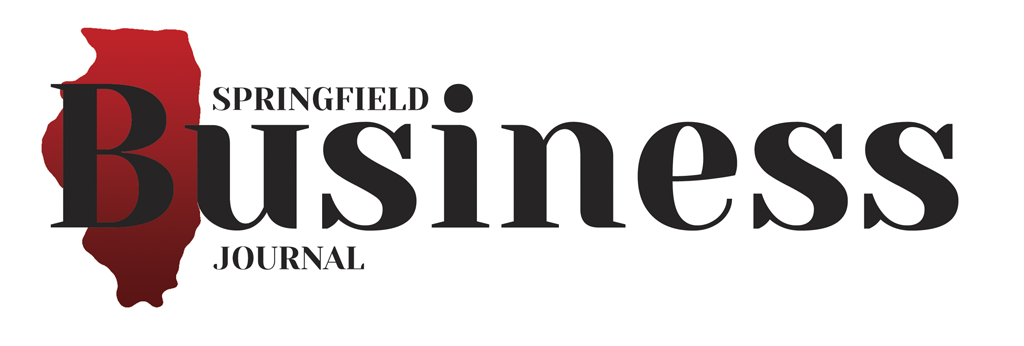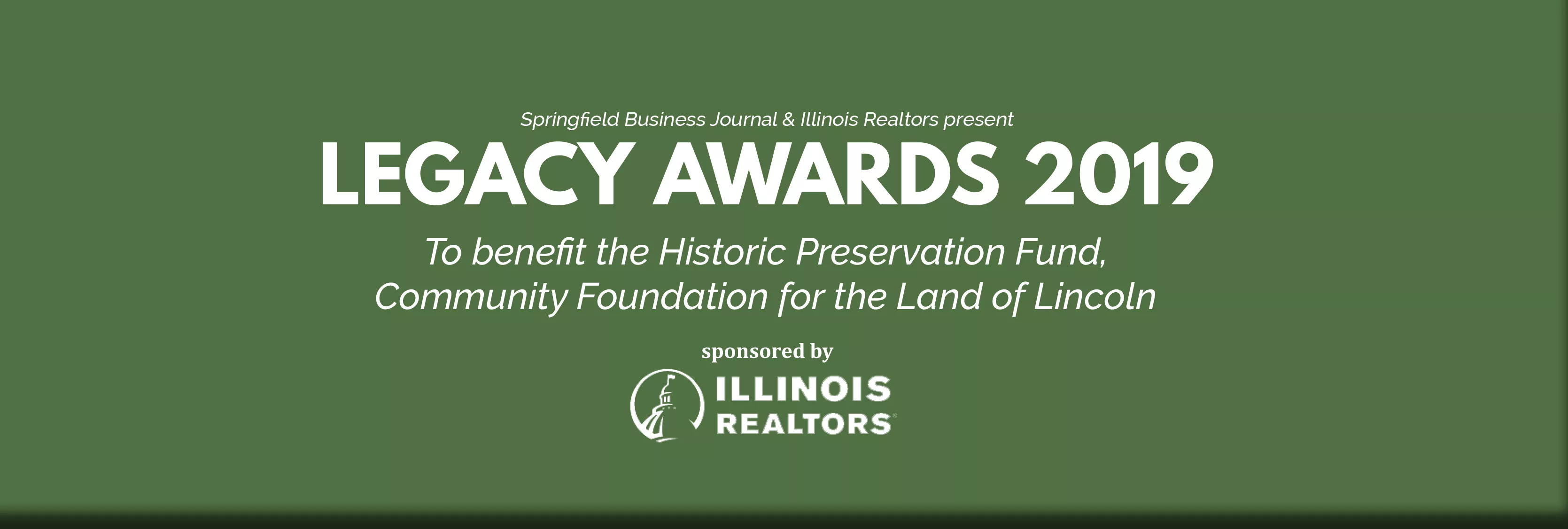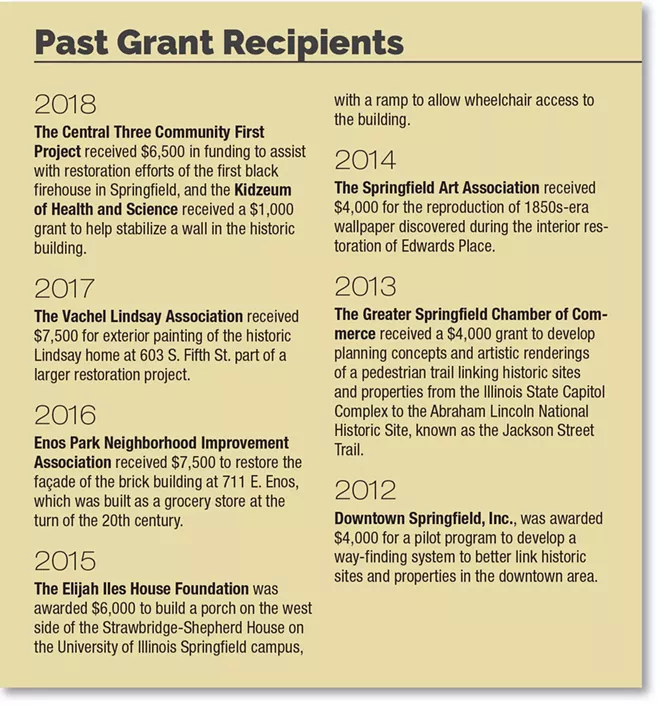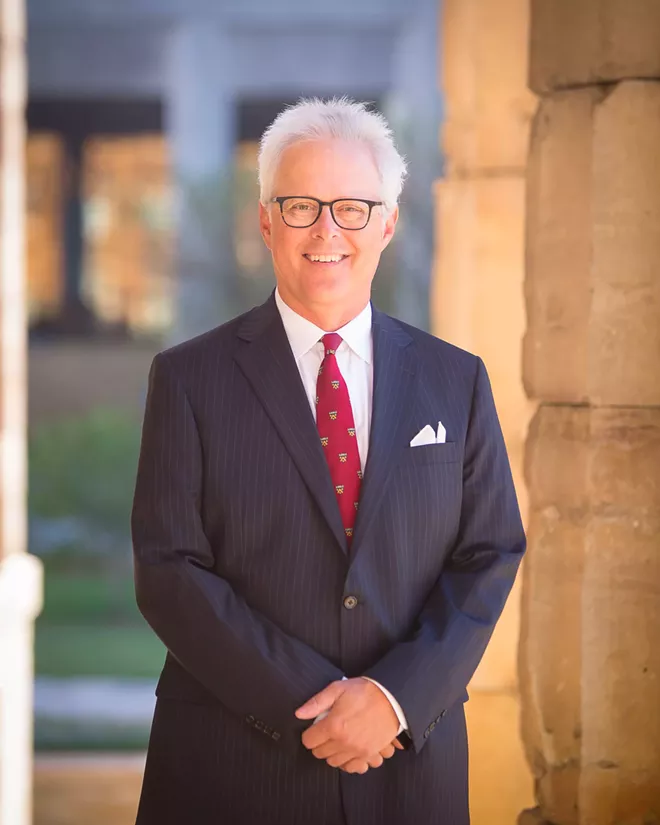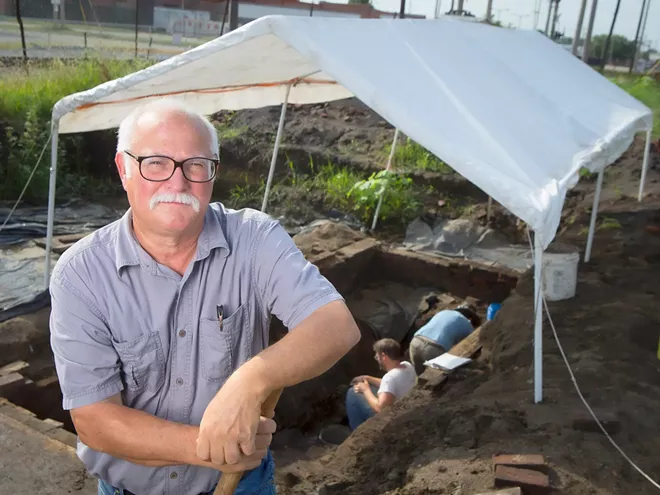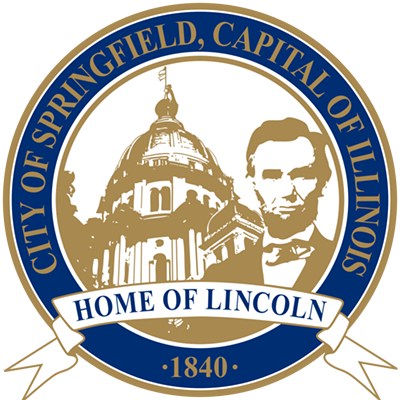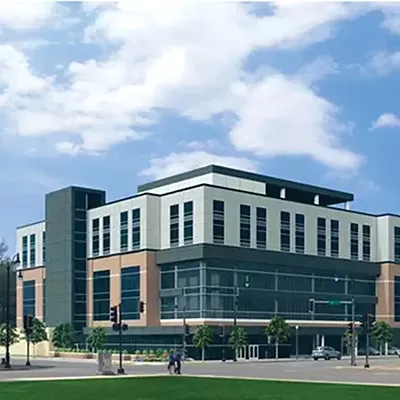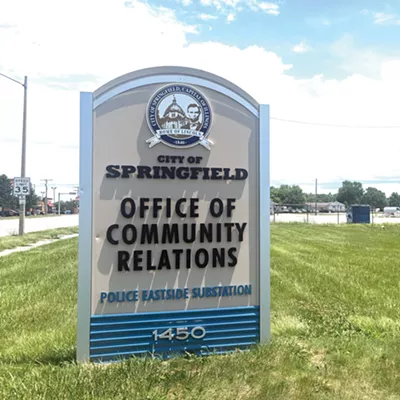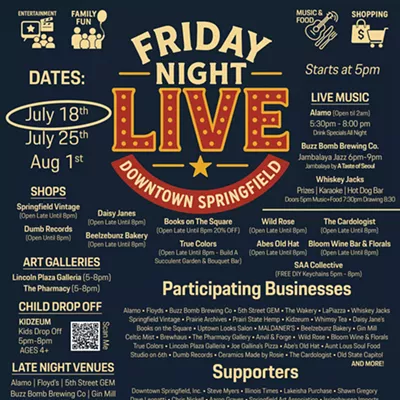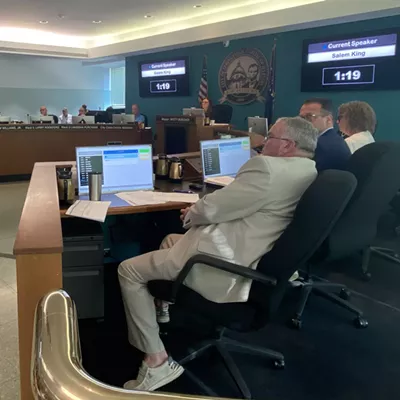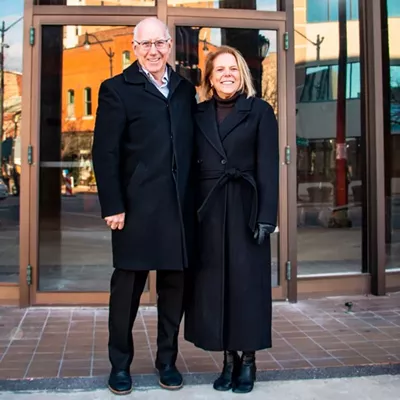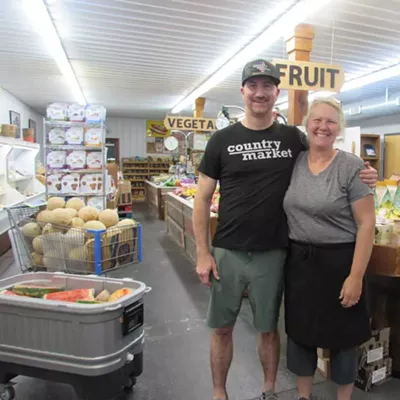

Historic Preservation Fund makes two grants for 2019
BY MICHELLE OWNBEYThe CFLL Historic Preservation Fund at the Community Foundation for the Land of Lincoln has awarded 2019 grants totaling $7,500 to support preservation efforts to two different organizations. The grants will be presented at the Springfield Business Journal’s 2019 Legacy Awards program on Sept. 4.
The Oak Ridge Cemetery Foundation received $5,500 to reinstall Oak Ridge Cemetery’s 1900s-era iron archway sign. Originally located at the cemetery entrance on First Street, it will now be located in front of the existing bell tower and east of the Lincoln Receiving Vault.
The James Project received $2,000 to restore a wooden door and entryway to a more than 100-year-old home in Hawthorne Place. The nonprofit is a Christian ministry which provides homes and support for fostering families in Sangamon County.
Over the past eight years, the CFLL Historic Preservation Fund has awarded nearly $50,000 to 10 different recipients. The CFLL Historic Preservation Fund started in 2008 with just few hundred dollars left over from the Old State Capitol’s 40th Anniversary Celebration and was established as a field of interest fund to assist nonprofit organizations in funding historic preservation projects in Springfield. Projects are sought that support the physical improvement of structures and/or promote the issue of historic preservation in our area.
An annual gala and a solicitation to Springfield-area preservation supporters have helped grow the fund over the years. In lieu of purchasing tickets to attend the Legacy Awards event, attendees will be invited to donate to the Historic Preservation Fund.
50 years or fewer in business
Levi, Ray and Shoup, Inc.
BY CATHERINE O'CONNORHeadquartered in Springfield where the three founders, Richard (Dick) Levi, Roger Ray and Bob Shoup, started the company, LRS is celebrating 40 years in business this month. The LRS main campus, which stretches two city blocks along Farragut Drive, just off West Monroe, houses 361 employees. The corporate giant also has offices in 13 other US cities and seven in Europe, plus an office in Asia and Australia, for a combined total of 922 employees.
Looking back at the company’s history, Levi said, “It’s hard to believe its been 40 years. It sometimes feel like four.”
There was no degree or professional field known as information technology at the time, and the disc drive had not yet been invented, when Levi’s interest was peaked during college while working part-time at the telephone company in Mattoon.
“Then I took a computer programming class as an elective in the math department. We actually had tapes and used punch cards at that time,” Levi explained. Starting with a degree in business management and no source of outside capital, Levi had no idea how the company might grow and evolve.
In 1979, the founders bought three used desks and six chairs from an office supply salesperson with whom LRS still does business and opened an office in 900 square feet of rented space in downtown Springfield.
During the years that followed, they opened several new offices and completed many acquisitions, which has resulted in steady upward growth with only a few slight downward “blips,” according to Levi, who said, “Our growth has remained slow, steady and primarily organic.”
His financial strategy has been to always protect the company from the potential of a down year. “Because you don’t always know what the future will bring,” he said, explaining why all debt was paid off during the first year in business. Remarkably, the company has never borrowed a penny since.
“One benchmark was our decision in the early 1990s to expand our offices internationally instead of relying solely on outside distributors in those markets. We grew from $176,000 in revenue our first year to over $250 million in our fiscal year ending in 2018,” Levi said.
When LRS began marketing its software in the early 80’s, the company outsourced marketing both in the US and in Europe. Later, LRS began marketing in-house, which has been essential as product offerings have multiplied.
“The biggest change in our marketing strategies has been the emerging importance of the internet in our efforts. We have a website that reaches potential customers, and we host webinars that attract people from around the globe,” said Levi.
LRS has also gained a reputation as a great place to work. More than 40 employees have achieved the 25-year longevity mark, and nearly 20 of the staff have been with the company 30 years or more.
The company has also exceeded IT industry standards in its hiring and promotion of women in the workplace and had woman in leadership roles from the beginning. Levi said that a female project manager who was hired in 1980, less than a year after the start-up, is still with the company today.
Legacy and family have played an important role in the structure of LRS, with Levi making his two sons and son-in-law an integral part of the business. “Honestly, I’m now pretty much a figurehead,” said Levi, “though I come to the office every day and have involvement in key business decisions.”
LRS has also made many contributions to the community at large and has a long history of supporting local organizations, including Hope School, Memorial Center for Learning and Innovation, the Springfield YMCA, Hoogland Center for the Arts, Kidzeum of Health and Science, MERCY Communities and Girls on the Run.
In 2002, the LRS Foundation was established with the primary purpose of giving back to the community which has been their hometown for so many years. “We feel very fortunate to have had the amount of success we have had here and simply believe that giving back to the community is the right thing to do.” said Levi.
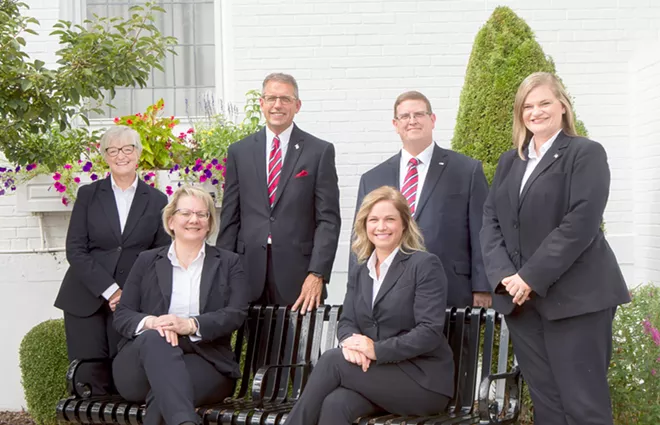
51-100 years in business
Butler Funeral Homes & Cremation Tribute Center
BY HOLLY WHISLERChris Butler, CEO and president, is the third generation of the Butler family to own and operate the Butler Funeral Homes & Cremation Tribute Center. He said, “Community service has always been a strong thread in our family. Funeral service allows opportunities to serve the community in various ways.”
Butler Funeral Homes & Cremation Tribute Center has its beginnings in 1893 when Ben Kirlin and Ed Egan merged a funeral home and livery service to form Kirlin and Egan Funeral Home, located at Fourth and Adams streets. As the firm grew, the funeral home relocated to the west side of South Sixth Street, and in 1927, Kirlin and Egan moved the funeral home to its present address of 900 S. Sixth St. After their deaths, Ben’s daughter, Mary Kirlin, continued to operate the funeral home even though the industry was dominated by men at that time.
In 1940, longtime employee and manager of Kirlin and Egan Funeral Home, Harold Butler, assumed ownership of the firm and made additions to the mansion during the 1950s. Following Harold Butler’s death, his nephews, John B. “Jack” Butler and Jerome “Jerry” Butler, along with Leonard Berry and John J. McCarthy, purchased the firm in 1965.
After the death of John McCarthy, Jack and Jerry Butler became sole owners of the firm in 1970, adding the Butler name to the funeral home in 1972. Jack’s son, Chris, joined the firm in 1990 and purchased the business in 2002.
Since then, the firm has grown and expanded its offerings to meet the changing needs, preferences and expectations of its clients and guests. In addition to the flagship, Butler Funeral Home & Cremation Tribute Center in Springfield, the Butler Family of Organizations also includes two satellite locations. In 2005, Butler Funeral Homes became part of the New Berlin area communities with its purchase of the McCullough-Delaney Funeral Home. Last year, the Boardman-Smith Funeral Home, the oldest and most historic funeral home in Springfield having significant connections to members of Abraham Lincoln’s family, was acquired by the Butler Family of Organizations, along with Cremation Services of Central Illinois and Sangamon Prairie Reception Center in Chatham, which were founded by Paula Staab Polk.
Each unique branch of the Butler Family of Organizations has been established with great thought, planning and care. Tying it all together is an emphasis on exceeding expectations.
Chris Butler said, “There have been a lot of changes in the world and in our community but the needs of those who have experienced the death of a loved one are essentially the same as they have always been,” noting the importance of helping people say goodbye with dignity and respect.
Zack Wilson, director of operations, said, “Our culture is one of empathy, passion, engagement and teamwork. We have an environment of continuous learning where we grow personally and professionally while striving to achieve our mission. We value education and development of our associates to best meet our core obligation to our clients. We strive to create an environment where we have work-life balance and support each other.”
Cheryl Garvin, controller, agreed that the culture of mutual respect and empathy extends to how the associates treat each other and work as a team. “We strive to provide an opportunity of growth both professionally and personally to our associates. All associates have the opportunity to be truly vested in the organization and its mission of service,” she explained.
The Butler family recognizes that its longevity and success cannot be attributed to one person, but to the entire team that is committed to living out the values of the organization and conducting themselves with the utmost professionalism.
Looking to the future, Butler said, “We have associates who have demonstrated strong dedication to our organization, our clients and our family. We groom for the future partially in how we handle ourselves today. No matter what seat we occupy in our organization today, it will one day be occupied by someone else. Our obligation is to fulfill our role in the best manner possible, leaving the best chance of success in the future for those who come after us.”
Overall, Butler said, “We are constantly recharged and rewarded by families that we assist. Few of life’s rewards are better than having someone tell you that he or she does not know what they would have done without your help. Funeral service can be a beautiful way to help your neighbors and friends.”
100+ YEARS IN BUSINESS
Brown, Hay & Stephens
BY HOLLY WHISLER“On the morning of October 25, 1828, a tall, slender, handsome young man reined his horse and paused for a better view of the little prairie village which lay before him. John Todd Stuart, just twenty-one years of age, had heard glowing reports of the newly settled Sangamo country, and had determined to make it the setting for his career at the bar,” according to the 1978 self-published book, “One Hundred Fifty Years of Law,” written by Paul M. Angle and Robert P. Howard.
John Todd Stuart, cousin of Mary Todd Lincoln, hung his shingle on the corner of Sixth and Adams streets in 1828 and began practicing law in Springfield. The book notes that Springfield was only seven years old, but growing steadily as the permanent seat of Sangamon County.
Stuart rose to prominence and started taking on partners, one of whom was Abraham Lincoln in 1837, but it was his 42-year partnership with Benjamin Edwards in 1843, followed by partner Christopher Brown in 1860, that would make history. In 1921, the law firm officially became known as Brown, Hay & Stephens (BHS) – now the oldest and one of the most respected law firms in Illinois.
BHS occupies space in the U.S. Bank building in downtown Springfield – the same building where Stuart, Edwards and Brown established their firm in 1858. At the time, it was the Bunn Bank building and was known as the finest business structure in Springfield, and the law firm had a reputation for having the finest lawyers practicing there.
The firm has now grown to occupy three floors of the U.S. Bank building. Several years ago, when the firm needed more space, the decision was made to honor its roots and invest in a major renovation so the firm could stay downtown. In 2020, BHS will celebrate 100 years in the same building, as one of the original tenants. BHS attorneys specialize across a broad range of practice areas and the firm is managed by a five-member committee consisting of Hugh Drake, Lorilea Buerkett, Erica Riplinger, Roland Cross and managing partner Jeff Wilday.
According to Drake, “We are a relationship-driven business, which depends on a strong, firm-wide work ethic. We value our reputation for integrity throughout the firm’s long history. We are a firm, not a collection of lawyers, which uses a collaborative effort to provide effective and efficient solutions for its clients.”
When it comes to bringing new attorneys on board, BHS considers a variety of factors. Buerkett explained, “In addition to a strong academic record, it is important for an applicant to have demonstrated a strong work ethic and the ability to work in a team environment. Also, applicants need to show an interest in becoming involved in the community. In that regard, our youngest partners have set a very high bar in terms of community service and networking with other young professionals in accounting, banking and business, setting a good example for our associate attorneys.”
With 30 or more attorneys now working for the firm at any given time, the partners intentionally seek out activities that will allow for company-wide interaction. “Maintaining a sense of cohesion and teamwork has become more difficult as the number of attorneys and support staff has increased and our office space has grown from one floor to three,” said Riplinger. “We regularly engage in group activities which help build camaraderie. For example, attorneys and support staff have raised funds for Big Brothers Big Sisters through the Bowl for Kids’ Sake event every year since 1998. And last year was our first year of having a firm float in the city’s Christmas parade. This turned out to be especially popular among those at BHS with young families.”
While it’s difficult to know exactly what the firm’s philosophy was in the 1800s, the attorneys at BHS have always been heavily involved in community service, a tradition that continues today.
Davis said, “Our attorneys are actively engaged in leadership positions in a wide variety of civic, charitable and social organizations. We are particularly enthusiastic about our participation in the new Innovate Springfield group which enables our attorneys to answer legal questions for young entrepreneurs who are considering start-up businesses.”
As the managing partner, Wilday feels the hallmark of BHS has been its ability to maintain longstanding client relationships with businesses, public and private sector organizations, and individuals.
“At its core, maintaining a successful legal practice depends on personal service. Going forward, we will work hard to provide the service and results needed to preserve all of the firm’s current relationships while establishing new ones. To do so, we will continue to hire talented new law school graduates while seeking to expand into new practice areas through lateral hires who share the firm’s core values,” Wilday said.
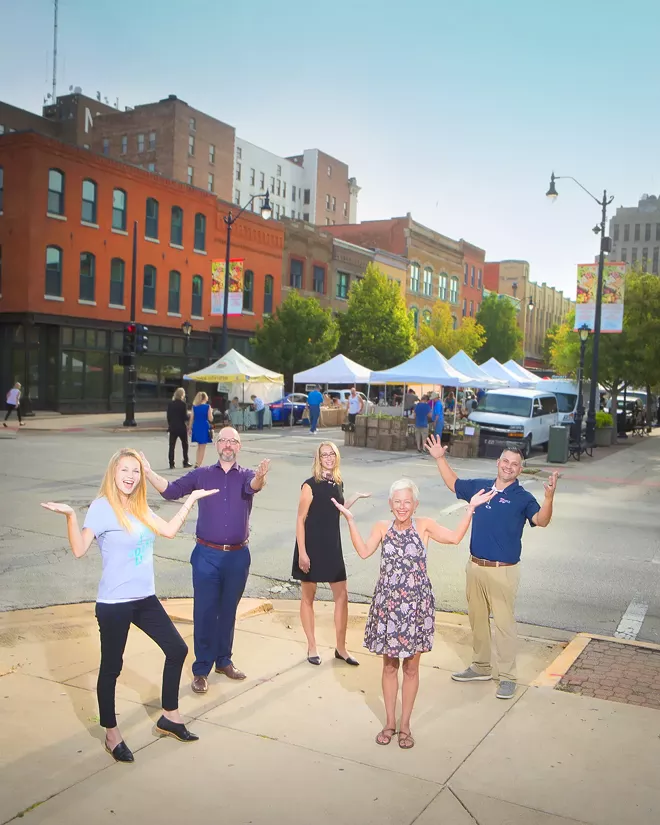
Preservation Advocate - Organization
The Adams Family
Kidzeum of Health and Science, Café Moxo, Buzz Bomb Brewing, Just the Basics Mobile Bar, The Elf Shelf Books & Music, Itty Bitty Fashion Trunk, Kiddos by Urban Sassafras
BY CAREY SMITHThe moment you turn right from Fifth Street onto Adams Street, the vibe of downtown Springfield changes. Vibrancy and originality delight the eye with every glance. Mid-block, a pedestrian crosswalk encourages you to park, to take your time in looking around, to meander through this slower-paced, but somehow more animated, neighborhood of locally owned businesses.
The Adams Family is a collection of small business owners, along with one nonprofit organization, located in the 400 block of East Adams who designed their own business model.
Forinash is a longtime resident of this block of businesses and humble founder of the Adams Family: “In the end I have to worry about Café Moxo; that’s where my focus is. But along the way, can I make some really good friends and work with people that I enjoy working with and create a buzz and have a little bit of fun?”
A cooperative business model is not a page out of any contemporary rule book, but this group of small-business owners has not only made it work, but flourished in their efforts. “It’s a catalyst for development of downtown,” says Wilson, executive director of the Kidzeum. “It’s just the beginning of something that could create a lot of vibrancy downtown, [which] needs a variety of different venues and amenities and attractions to get as many people to come.”
Although a brewery and a children’s museum may not have much in common on the surface, as Flanders explains, “We all have shared interests and a deep commitment. I think that’s one thing that separates this street, that everybody on it is committed, not just to the street, but to downtown and to mutual success.” Regan states, “I think it’s really been amazing to see how positively the community gives feedback – everybody loves to see businesses working together. I think that’s something different than Springfield has ever seen before, let alone downtown.
The attraction of Springfield’s downtown, and especially the Adams Family, according to Wilson, is its authenticity. “I think people want authentic experiences, and you get that when you go into Buzz Bomb. You see the things they made by hand, or you frequent a small business where they hand-curated all the items that they have in it. It’s a very different feeling to come downtown and to know that you can have a connection with a business owner who lives here and invests here – it’s not the same as going to a mall. I think people are really just craving that real connection.”
Wilson added, “I think it’s those relationships as well. It’s not something you can get if you’re shopping on Amazon or online, to actually have a friendship with a person and patronize their business is very different. I think more and more people are going to find that if they just get over some of their preconceptions they might have, and they take the time to visit all of us, they’re going to feed off of the passion and have a great experience that they tell their friends about.”
When asked about the vision for taking this cooperative model 20 years into the future, Regan responds, “My vision is every day being like the Saturday morning farmers market. You see so many people walking around with their dogs and their families, and different walks of life all from around this community. That would be amazing to see that all the time.”
But this cooperative business model need not stop at the boundaries of the 400 block of East Adams. As Forinash asserts, “We’d love this to expand, and it’s certainly a goal that I have that Adams doesn’t necessarily have to stop here. There are really neat places down here, and I have got to do a better job in expanding that, because it’s not just our block. It’s just really easy to walk 25 feet, and that’s the furthest we have to walk to talk to somebody.”
Preservation Advocate - Individual
Floyd Mansberger
BY CAREY SMITHUncovered after archaeological testing mandated by the 10th Street rail corridor federal project, the archaeological dig on East Madison Street, just west of the 10th Street railroad tracks, is a site which evokes many different intense emotions. Seeing the brick foundations of homes burned in the 1908 Springfield Race Riot, reading the storyboards on site of the history of this place and its people and viewing the artifacts found in the burn layer is a visceral reminder of the racial divide and scars of our collective history.
Floyd Mansberger of Fever River Research shines a light on this buried past. He has worked in Springfield full time since 1985 but describes this project as one of the most complex in his career. “It’s also one of the more significant projects I’ve ever worked on and one that I’m quite honored to participate in,” he said.
What Mansberger does so well is to bring the history of the site and its people out into the open. The artifacts he and his team have found are brought to the surface, cleaned up, researched and related directly to the people who lived in the homes.
Several military medallions were recently uncovered from the Illinois Militia’s 8th Regiment, which was solely comprised of African-American troops who arrived in Cuba at the tail end of the Spanish-American War in 1898-99 and functioned as peacekeepers. Through archival research, these medallions were found most likely to belong to Robert N. Wright, an African-American painter and laborer. Mansberger noted, “Potentially Mr. Wright, having not seen combat in Cuba, was ‘front and center’ for one of the more horrific events in Springfield’s history.”
Mansberger adds, “The significance to me is to talk about who these people really were – not the perceptions of who these people were in 1908 by the contemporary newspapers and such – but to see that these were real humans, and they were trying to survive the best they could. It just allows us to begin the conversation that’s relevant for today to revisit that event – what happened, why did it happen, and heaven forbid, prevent it from happening again. With things the way they are today, it’s extremely relevant.”
Shocked that a race riot that took the lives of at least 16 people could happen in Abraham Lincoln’s hometown, a movement was born. Less than six months later, the National Association for the Advancement of Colored People (NAACP) was formed, with its current mission statement echoing its past: to secure the political, educational, social and economic equality of rights in order to eliminate race-based discrimination and ensure the health and well-being of all persons.
“What makes me feel honored to be working on it is its national significance,” says Mansberger. “Events that occurred here had national importance. And a lot of what I’ve been working on, I hope I do it justice, and I hope we learn something about who we are now from what transpired back then.”
The site is currently open to the public, and people are welcome to visit Mansberger on-site. In mid-September, the project will wind down, and the dig site will be filled with soil and covered with grass. If all goes well, a bipartisan effort will result in installing a memorial at the site, an invitation to remember our collective past as well as an invitation for collective healing.
“We hope that it will proceed,” says Mansberger, “and we’ll have a little sliver of land devoted to the civil rights movement in the United States right here. It fits in very well with the whole theme of Lincoln and his home and what he stood for and worked for.”
Mansberger is more than an archaeologist. Through his archaeology, he is able to tell the stories we most need to hear in our current era of fear and marginalization of diverse cultures. As Mansberger asks, “I mean, have we grown? Yes. Can we grow further? Yes. And this project allows us to talk about some of that.”
